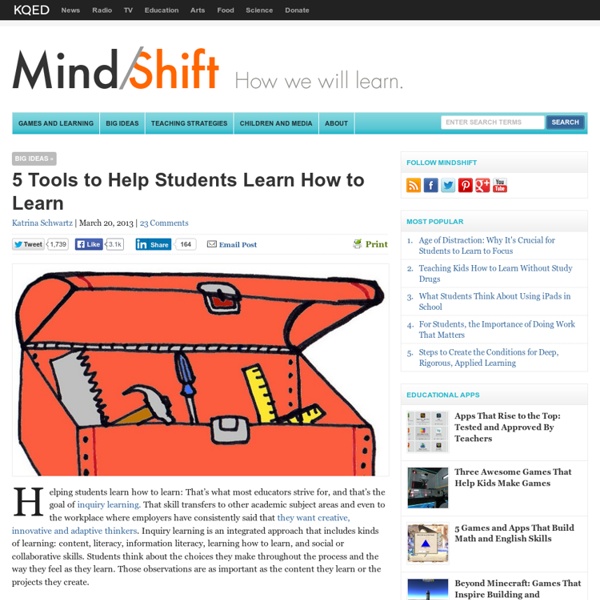Curious Homework: An Inquiry Project for Students and Parents
Photo credit: iStockphoto International educator Scot Hoffman is a big believer in the power of curiosity to drive learning. After nearly two decades of teaching around the globe, he also realizes that school isn't always so hospitable to inquiring minds.
Service Learning : Teaching and Learning : The University of Western Australia
Enquiries All queries should be forwarded to Aden Date Service Learning Coordiinator. Current service learning units
5 Excellent Strategies to Teach Students how to Learn
" Give a man a fish and he'll eat for a day but teach him to fish and he'll eat for a lifetime " this quip summarizes the essence of education and learning. Teach students how to learn and they will learn for the rest of their lives.The focus should be on the process not the end product, but unfortunately today's educational system with its emphasis on high stake tests and standardized assessment puts the cart in front of the horse and turn students into empty pails that require filling up each time they are to pass a test. To redress the situation and empower our students with the learning and social skills they need to thrive in tomorrow's job market, inquiry based learning is the answer. Just like the 6 other important learning strategies I talked about in an earlier post here in Educational Technology and Mobile Learning, inquiry-based learning should have the lion's share in your teaching practice. 1. An Inquiry Community is the class itself.
What is Mindset
Every so often a truly groundbreaking idea comes along. This is one. Mindset explains: Why brains and talent don’t bring success How they can stand in the way of it Why praising brains and talent doesn’t foster self-esteem and accomplishment, but jeopardizes them How teaching a simple idea about the brain raises grades and productivity What all great CEOs, parents, teachers, athletes know Mindset is a simple idea discovered by world-renowned Stanford University psychologist Carol Dweck in decades of research on achievement and success—a simple idea that makes all the difference. In a fixed mindset, people believe their basic qualities, like their intelligence or talent, are simply fixed traits.
Creating Classrooms We Need: 8 Ways Into Inquiry Learning
If kids can access information from sources other than school, and if school is no longer the only place where information lives, what, then happens to the role of this institution? “Our whole reason for showing up for school has changed, but infrastructure has stayed behind,” said Diana Laufenberg, who taught history at the progressive public school Science Leadership Academy for many years. Laufenberg provided some insight into how she guided students to find their own learning paths at school, and enumerated some of these ideas at SXSWEdu last week. 1. BE FLEXIBLE.
Inquiry Learning Vs. Standardized Content: Can They Coexist?
By Thom Markham As Common Core State Standards are incorporated from school to school across the country, educators are discussing their value. It may seem that educators are arguing over whether the CCSS will roll out as a substitute No Child Left Behind curriculum or as an innovative guide to encourage inquiry rather than rote learning. In reality, as time will prove, we’re arguing over whether content standards are still appropriate.
Assessment and Rubrics
Learn more about our Online Courses, Online Certificate Programs, and Graduate Degree A collection of rubrics for assessing portfolios, group work/cooperative learning, concept map, research process/ report, PowerPoint, oral presentation, web page, blog, wiki, and other social media projects. Quick Links to Rubrics Social Media Project Rubrics Wiki RubricCriteria for assessing individual and group Wiki contributions. Blog RubricAssess individual blog entries, including comments on peers' blogs.
Student-Centered Learning: The First Steps Are the Hardest Ones
Educator Melba Smithwick never had too much difficulty trying out new ideas. But when a new principal encouraged a small group of teachers to give students more say in their learning, Smithwick hesitated. Included: Smithwick shares her first, tentative steps. I have always been a risk-taker.
StriveTogether
Skip to main content Knowledgeworks StriveTogether EDWorks Every child.




me donne des astuces pour mes élèves. ,précisemment pour leur enseigner comment etudier by nathaliechemegnenzeale Apr 14